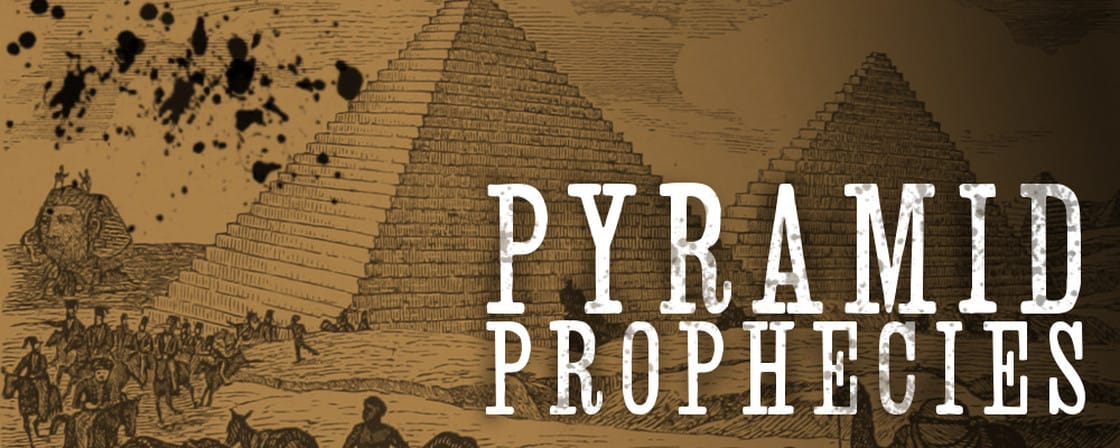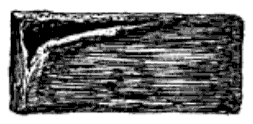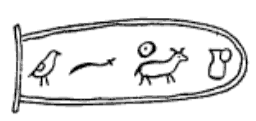Frank H. Norton
April 7, 1894
|
NOTE |
In the late nineteenth century, conspiracy theories about the pyramids of Egypt proliferated, many centered on an effort to prove that the Judeo-Christian God was somehow responsible for its construction. The following article, which was published in 1894, distills these conspiracy theories into a a condensed package that unintentionally resembles the claims made for the Great Pyramid in fringe history works from the twentieth and twenty-first centuries, all while retaining the charm of predicting the end of the world for the year 1901.
|
Volumes and monographs innumerable have been written concerning the Great Pyramid. It has been made to prove the antiquity of the “British inch,” to predict the Declaration of Independence, and to declare the spiritual origin of the American flag. Yet to-day it out-sphinxes the Sphinx in obscurity. and continues to dominate the earth as the insolvable secret to which the Sphinx itself is, maybe, the password. One hypothesis more or less will hardly alter the stability of the Pyramid, so I may venture on one which will have at least the virtue of novelty, and which will, at the same time, pursue the course of these papers in the direction of the same general conclusion.
About ten years ago I contributed, by request, to a scientific publication, which has since passed out of existence, a short paper on the celebrated “coffer” in the king’s chamber, in the interior of the Great Pyramid of Ghizeh. It is the hypothesis alluded to in that paper with which I purpose dealing briefly in the present article.
Pyramid mensuration has been very widely recognized by astronomers, and other scientific persons, as having obvious relation with the earth’s mean distance from the sun, as well as with other important measurements and proportions. Certain writers have claimed for the Pyramid also a prophetic mission bearing upon a Messianic reappearance. One such claims that as the birth of Christ occurred at the period “when shepherds watched their flocks by night,” it must have been in that latitude at or about the September equinox, or when the sun enters Capricorn—this, by the way. Another writer contends that the origin of the Pyramid is antediluvian, holding that the theory of its having been constructed by King Cheops (Shoofu, or Kufu, fourth dynasty) and in B. C. 2,170, is based on an infirm foundation. This theory depends, partly, on the astronomical fact that the star a Draconis was the pole star at that time. and was visible through the angular passage in the Pyramid extending from the subterranean chamber. Partly, also, it is based on the existence of a cartouche (assumed to be that of King Cheops) inscribed in the interior of the Pyramid, and also in a rock tablet at Wady Magharah. a quarry whence the stones for its construction were taken. The cartouche is of the most archaic form known; it may be observed that it bears some resemblance to a fish.
About ten years ago I contributed, by request, to a scientific publication, which has since passed out of existence, a short paper on the celebrated “coffer” in the king’s chamber, in the interior of the Great Pyramid of Ghizeh. It is the hypothesis alluded to in that paper with which I purpose dealing briefly in the present article.
Pyramid mensuration has been very widely recognized by astronomers, and other scientific persons, as having obvious relation with the earth’s mean distance from the sun, as well as with other important measurements and proportions. Certain writers have claimed for the Pyramid also a prophetic mission bearing upon a Messianic reappearance. One such claims that as the birth of Christ occurred at the period “when shepherds watched their flocks by night,” it must have been in that latitude at or about the September equinox, or when the sun enters Capricorn—this, by the way. Another writer contends that the origin of the Pyramid is antediluvian, holding that the theory of its having been constructed by King Cheops (Shoofu, or Kufu, fourth dynasty) and in B. C. 2,170, is based on an infirm foundation. This theory depends, partly, on the astronomical fact that the star a Draconis was the pole star at that time. and was visible through the angular passage in the Pyramid extending from the subterranean chamber. Partly, also, it is based on the existence of a cartouche (assumed to be that of King Cheops) inscribed in the interior of the Pyramid, and also in a rock tablet at Wady Magharah. a quarry whence the stones for its construction were taken. The cartouche is of the most archaic form known; it may be observed that it bears some resemblance to a fish.
As is seen, this cartouche contains the figures of a bird, a snake, a goat, a ewer or pitcher. and a disk with a point in the centre. The pitcher certainly suggests water—and the sign Aquarius—just as the goat does the sign Capricornus. And as the circle with the dot is the equivalent of the Egyptian “Ra”—the sun—it does not require a very violent stretch of the imagination to assume that the ideographs meant that, at some period. when the sun was in the sign Capricornus. an event of a watery character would happen. Taken in connection with the curious prediction of Berosus, the priest of
Bel, in Alexandria, that when the planets coincided in Capricornus, the world would be destroyed by water, the existence of this cartouche within the Pyramid is not without a certain value as coincident testimony.
There is no need, however, to draw on the imagination for suggestion in the case of these hieroglyphics, for we have in such an authority as M. Champollion the exact definition of the different forms employed in the cartouche; thus, the bird means “to guard, to preserve,” and the pitcher and the goat stand for the letters N and B. and mean the god Neb or Noum, who was the Egyptian primordial deity, instead of King Cheops. But not only this. The disk, with the point in the middle, and the goat, taken together symbolically, also mean Noum, as the sun-god. The snake is a symbol which stands for the masculine nature of the god, as many of these deities expressed both sexes, or either of them. at will. Finally, Noum was the “Nile god,” and specially designated the heliacal rising of that river; he would consequently be the natural god to select as a symbol of a general flood.
But the evidence that the intent of the Great Pyramid was to note the fact of such a catastrophe occurring at certain periods, increases when we examine the “coffer” by the same light. This coffer stands in the “king’s chamber,” and is an oblong box. cut out of a solid block of granite, and 90 inches long. 41 inches high, 39 inches wide outside, the walls being 6 inches thick. Its capacity is four Anglo-Saxon quarters, or 32 bushels.
This coffer was long ago conceded not to be a sarcophagus. It has no lid, though there are grooves for a sliding lid; and a peculiar feature regarding it. is that it is too large to have ever been carried into the place, where it is, through the entrance passage. The use of this receptacle for something has never yet been divined by any of the Pyramid students. The suggestion is here offered that it was designed to contain water, and thus signify the medium by which a future great earth destruction was to be accomplished. It will be seen in in the cut that the coffer has been badly damaged by some means; and as it is known that it does not now stand in the same spot in the chamber that it did originally, and as there is evidence in the rock underlying the Pyramid that it has suffered from some terrible earth convulsion, this change of place is not remarkable. The temperature of the king’s chamber never varies; and if the coffer had once contained water. and the lid had not been removed by some of the Arabs or other barbarians who once broke into and ravaged the Pyramid, that water would have remained in the coffer for all time. Prof, James Simpson, of Edinburgh, began a paper on the “Geometry of the Coffer “ as follows: “As a standard measure of volume and weight, the coffer has been successfully and beautifully connected with the earth-globe through the medium of the mean specific gravity ratio of 5.7 water, thus showing how perfectly it fits into and completes the system of metrology wrought into the masonry of the Great Pyramid.” Yet, curiously enough, neither he nor anyone else has ever yet suggested the possibility that the including of this ratio was one of the simple methods devised by the constructer of the coffer for directing the attention of posterity to this very element—water. The coffer is, geometrically, the key to the Pyramid, as the Pyramid is the key to the problem of the when of the grand catastrophe that must inevitably accompany, periodically, the precession of the equinoxes. If that when is, as Berosus asserted, “when the planets coincide in the sign Capricorn,” then the year 1901 is certainly significant. Working on entirely different lines (the prophecies of Daniel), Mr. H. Grattan Gwinness, in his “Approaching End of the Age,” under date 1879, gives 1919 as the farthest period possible for the great conclusion.
FRANK H. NORTON.
Bel, in Alexandria, that when the planets coincided in Capricornus, the world would be destroyed by water, the existence of this cartouche within the Pyramid is not without a certain value as coincident testimony.
There is no need, however, to draw on the imagination for suggestion in the case of these hieroglyphics, for we have in such an authority as M. Champollion the exact definition of the different forms employed in the cartouche; thus, the bird means “to guard, to preserve,” and the pitcher and the goat stand for the letters N and B. and mean the god Neb or Noum, who was the Egyptian primordial deity, instead of King Cheops. But not only this. The disk, with the point in the middle, and the goat, taken together symbolically, also mean Noum, as the sun-god. The snake is a symbol which stands for the masculine nature of the god, as many of these deities expressed both sexes, or either of them. at will. Finally, Noum was the “Nile god,” and specially designated the heliacal rising of that river; he would consequently be the natural god to select as a symbol of a general flood.
But the evidence that the intent of the Great Pyramid was to note the fact of such a catastrophe occurring at certain periods, increases when we examine the “coffer” by the same light. This coffer stands in the “king’s chamber,” and is an oblong box. cut out of a solid block of granite, and 90 inches long. 41 inches high, 39 inches wide outside, the walls being 6 inches thick. Its capacity is four Anglo-Saxon quarters, or 32 bushels.
This coffer was long ago conceded not to be a sarcophagus. It has no lid, though there are grooves for a sliding lid; and a peculiar feature regarding it. is that it is too large to have ever been carried into the place, where it is, through the entrance passage. The use of this receptacle for something has never yet been divined by any of the Pyramid students. The suggestion is here offered that it was designed to contain water, and thus signify the medium by which a future great earth destruction was to be accomplished. It will be seen in in the cut that the coffer has been badly damaged by some means; and as it is known that it does not now stand in the same spot in the chamber that it did originally, and as there is evidence in the rock underlying the Pyramid that it has suffered from some terrible earth convulsion, this change of place is not remarkable. The temperature of the king’s chamber never varies; and if the coffer had once contained water. and the lid had not been removed by some of the Arabs or other barbarians who once broke into and ravaged the Pyramid, that water would have remained in the coffer for all time. Prof, James Simpson, of Edinburgh, began a paper on the “Geometry of the Coffer “ as follows: “As a standard measure of volume and weight, the coffer has been successfully and beautifully connected with the earth-globe through the medium of the mean specific gravity ratio of 5.7 water, thus showing how perfectly it fits into and completes the system of metrology wrought into the masonry of the Great Pyramid.” Yet, curiously enough, neither he nor anyone else has ever yet suggested the possibility that the including of this ratio was one of the simple methods devised by the constructer of the coffer for directing the attention of posterity to this very element—water. The coffer is, geometrically, the key to the Pyramid, as the Pyramid is the key to the problem of the when of the grand catastrophe that must inevitably accompany, periodically, the precession of the equinoxes. If that when is, as Berosus asserted, “when the planets coincide in the sign Capricorn,” then the year 1901 is certainly significant. Working on entirely different lines (the prophecies of Daniel), Mr. H. Grattan Gwinness, in his “Approaching End of the Age,” under date 1879, gives 1919 as the farthest period possible for the great conclusion.
FRANK H. NORTON.
Source: Frank H. Norton, “Pyramid Prophecies,” The Illustrated American, April 7, 1894, p. 389.





